Counselling psychologist Niamh Delmar shares her advice to coping with SAD.
It is that time of year when the days get shorter, less daylight is absorbed and people will be leaving for work, school or college in the dark and returning in the dark.
Seasonal affective disorder is a type of depression that occurs during the autumn and winter months. Approximately 3% of the population have a depressive episode induced by autumn and winter, and relieved by the arrival of Spring.
On a much lesser scale, some people can be affected by depression in the Spring and Summer. While many people may be hit with the "winter blues", SAD is more extreme and impacts daily functioning.

According to the American Psychiatric Association, SAD is a major depressive disorder with seasonal patterns. If a person has symptoms of depression, experiences episodes for two consecutive years during specific seasons and it occurs more frequently than during the rest of the year, a diagnosis of SAD may be made. Onset is usually in early adulthood and is more prevalent among women than men.
As with all mental health conditions, there are biological, psychological and social factors interplaying. You may be vulnerable to SAD if you have another mood disorder, have a family history, live far north or south of the equator, or in countries with long periods of cloud cover.
When sunlight gets reduced, your biological clock shifts. This leaves some people unable to adjust to the related changes in hormones, mood and sleep. If there is serotonin deficiency in the brain, a lack of sunlight reduces this even further, which can result in depression.
A reduction in Vitamin D from sunlight can also impact serotonin, lowering mood. Sunlight deprivation can lead to melatonin overload which influences sleep and mood. It disrupts the circadian rhythm which can be a contributory factor to feeling sluggish and lethargic during the winter.
The inner workings of some peoples' brains will fluctuate with varying levels of light triggering mental distress during the winter. The Christmas period is a further challenge to those struggling with SAD as the festivities and expectations amplify their mood.

Symptoms of SAD
Signs and symptoms range from mild to severe. Most people describe a lack of energy most of the time with a persistent low mood and irritability. Hypersomnia (oversleeping), overeating, weight gain, decreased libido and being susceptible to physical ailments are common indicators.
A loss of interest, a lack of motivation, difficulty concentrating, social withdrawal, and or feeling hopeless or suicidal may feature. People often turn to alcohol or drugs, which exacerbates symptomatology. Thought processes may be distorted and the person plagued by rumination and negativity.
Remedies
1. Natural Light
Getting outside and soaking up as much natural sunlight as is possible from early autumn will help. Fresh air, nature, physical activity has been shown to yield positive influences on the mood.

2. Lifestyle
Healthy habits such as diet, hydration and limiting or eliminating mood altering substances such as alcohol and drugs.
3. Routine and structure
Morning rituals can set up the day ahead. Despite the struggle in the dark mornings, try to get up, do some stretching exercises, shower, get dressed, make your bed, eat breakfast and engage in a short mindfulness session, such as the Headspace app. Wrap the day around with some daily routines. Doing something, meeting someone or going somewhere provides stimulation and a sense of accomplishment.

4. Sleep
A survey by the Journal of Psychosomatic Research found that 80% of participants with SAD experienced hypersomnia and 10% reported winter insomnia with 5 % experiencing both and another 5% neither. Hypersomnia often signals poor sleep quality and is linked to the same health risks as sleeping too little. Alcohol can disrupt circadian rhythms and block quality sleep. With less daylight and Vitamin D, too much melatonin gets produced making you feel groggy during the day.
Consistent bedtime and rising times are beneficial. Set bedtime rituals to wind down such as having a lavender bath, listening to a light audio book or reading, writing down anything bothering you and avoiding screen. Sleep hygiene also refers to having a comfortable bed, a quiet dark room and a comfortable room temperature. If troublesome, get checked for sleep disorders such as sleep apnea.

5. Thought processes
For people with SAD, the darker and gloomier season evokes darker and gloomier thought processes. A depressed mood instigates negative thinking and negative thinking aggravates a depressed mood. Watch what you are thinking and try to keep thoughts healthy, helpful and accurate. Be aware they are distorted by the mood, and practise paying less attention to them.
6. Support
Avoid socially isolating yourself. When the mood gets depressed, it is common for people to retreat. They may just not feel up to social interactions. However, social isolation can exacerbate symptoms. You may not be up to big gatherings or parties, but you could meet friends on a one to one basis for short periods and arrange to do something at your pace and that suits you.

7. Therapy and medication
According to the National Institute for Health and Care Excellence (NICE), SAD should be treated the same as with other types of depression. The recommendations include cognitive behavioural therapy and or antidepressants. You can discuss option and any concerns with your GP.
8. Light therapy
Light therapy boxes can provide an effective intervention for SAD. A light therapy box mimics natural light and causes a chemical boost to your mood. The light box requires certain specifications, suitability and instructions, so it is best to consult with your healthcare provider.
While seasonal affective disorder is distressing, steps can be taken to lessen its severity.
If you have been affected by issues raised in this story, please visit: www.rte.ie/helplines.



